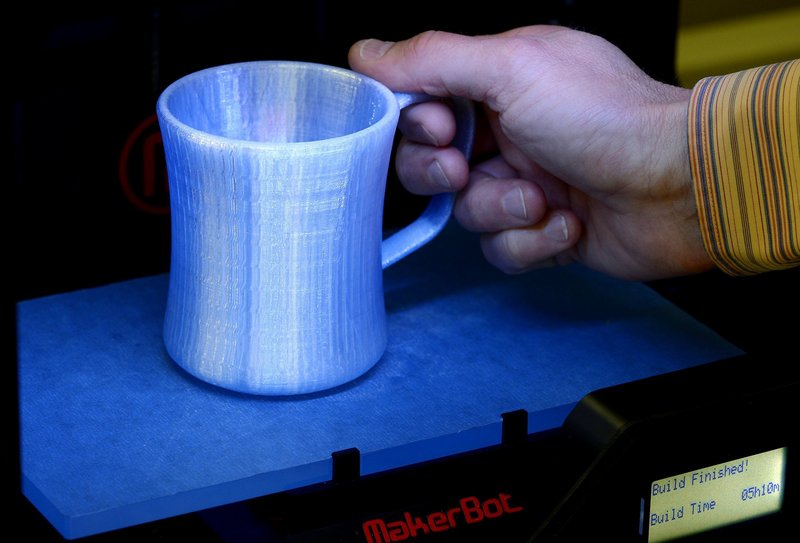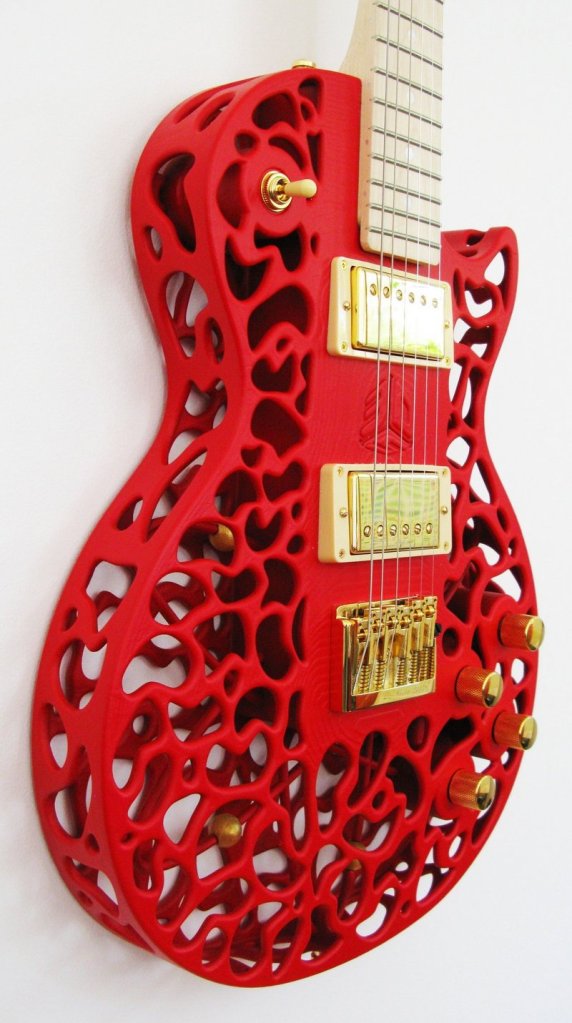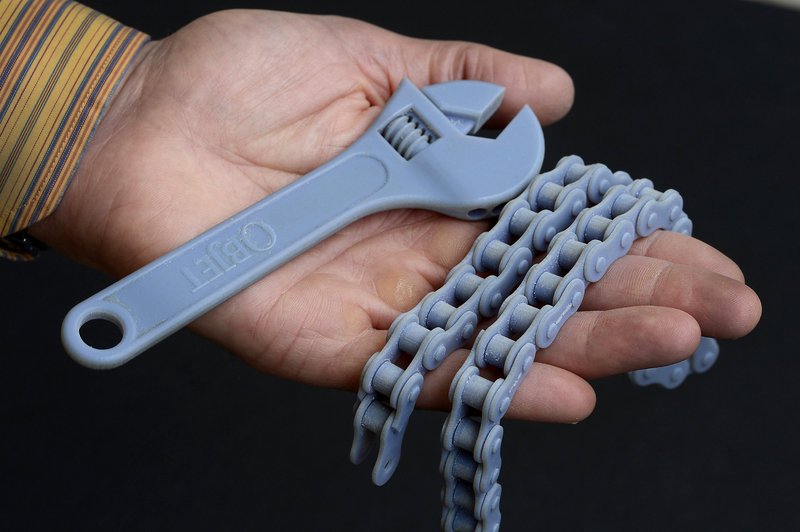KANSAS CITY, Mo. – Tim Middleton lives and breathes now, but the mind of the 42-year-old Eudora, Kan., man often floats to the future, to what one might call the printable life.
It is a time — with tangible signs popping up with increasing frequency around the globe — when nearly any product one needs is created by simply pushing a button and printing it out in usable three dimensions.
A pair of glasses? Print it.
A knee joint? Print it.
Red taillight lens for a ’65 Mustang? Print it.
“I have attempted printing my own shoes,” Middleton said, laughing.
He is a graphic designer who in the past two years has instructed more than 60 people on the art and science of 3-D printing in Saturday classes at Hammerspace, a community workshop in Kansas City for builders, hobbyists and inventors.
“They’re kind of hard,” Middleton said of his shoes. “The material is a little uncomfortable. But it is absolutely a possibility.”
More than possible: Such specialty 3-D-printed shoes already exist, produced and sold along with 3-D-printed nylon bathing suits, jewelry and dresses by Continuum Fashion of New York.
Cakes, cookies, sailboats, toys, architectural models, musical instruments, weapons, prosthetic hands and legs: All are items in recent years proved to be producible by 3-D printers.
Interest is high enough that the federal government last year earmarked $30 million to help support a new public-private institute in Youngstown, Ohio, dedicated to promoting and funding 3-D printing research.
It is a technology — although already considered overhyped in some circles — that many manufacturing experts say is even now only in its infancy, at a place similar to where personal and business computing was in the 1970s.
Like computing, they said, 3-D printing not only is likely to change the things we make and how we make and sell them, but also change how we live in good, bad and inconceivable ways.
“It is a bit tricky to predict,” said Hod Lipson, a professor of mechanical engineering at Cornell University and co-author with Melba Kurman of “Fabricated: The New World of 3D Printing,” a 2013 book on the promises and perils of an emerging technology.
“It is a little like trying to sit down in the 1970s and predict how computers were going to be used. Everyone could predict it would automate payrolls, but no one ever predicted social media.”
Given that caveat, Lipson predicted of 3-D printing: “It is going to change everything.”
Exactly when, how and how much, of course, is hard to say.
A May article in The New England Journal of Medicine described how two Michigan doctors used a 3-D printer to save an infant’s life by printing a custom tracheal splint to support the baby’s airway.
In the last year, meanwhile, one young man’s mission to use a 3-D printer to produce a workable handgun sparked immediate outcry from the public and concerned government officials who envision the technology being used to put caches of cheap and untraceable guns in the hands of criminals or terrorists.
In May, Cody Rutledge Wilson, a Texas law student who describes himself as a crypto-anarchist, test-fired a rudimentary handgun he created on a 3-D printer he bought on eBay. He released his gun design online, prompting the U.S. State Department to demand that he remove it.
Understanding 3-D printing and the future requires understanding how most products are made now.
The range is broad, from printing to stamping, casting to injection molding. Many manufacturing processes involve tooling or machining parts — a subtractive process that produces a part by cutting or chipping or shaving away.
“You start with a block of material and subtract things until you get what you want,” said Robert Landers, a professor of mechanical engineering at Missouri University of Science and Technology in Rolla.
But the first word in 3-D printing’s alternative name, additive manufacturing, tells how it is different.
Instead of chipping or cutting away at some material, a 3-D printer’s nozzle runs back and forth, over and over again, oozing out layer after layer of whatever material is inside. It could be spools of plastic, metal, ceramic or cookie dough. These printers have already been used to create a heart valve. Some predict the printers will use biological tissue to create entire replacement organs.
Instructions for what to build are guided by software, much of which is free online. The 3-D printer builds a whole object in place, as if it were growing from the bottom up. Or it creates parts of an object that can be assembled.
Printers can be small enough to fit on a desk, using spools of thermoplastic filament that looks like weed trimmer line. Or they can be huge, with nozzles pouring out stone-like material to create walls or 10-foot-tall sculptures.
A YouTube video from the MIT Media Lab shows a quick-motion video of a 3-D printer creating a playable flute.
In New Zealand, engineer Olaf Diegel’s experiments with 3-D printing spurred for him a new market in intricate electric guitars with hollow, lace-like bodies.
“I used to be a wannabe rock star,” Diegel said by email. “So two years ago, I decided to see if the 3-D printing technologies had improved to the point where they could make a real, working electric guitar. Not just a prototype, but the real thing, that could be sold as-is. It worked incredibly well, and I started blogging about it, and the business spun off from there.”
In Italy, inventor Enrico Dini, chairman of Monolite UK Ltd., has created a massive printer he calls D-Shape to create tall, sturdy and intricate stone-like sculptures, organically shaped with many large curves and holes that would be difficult to create using traditional building techniques.
Made of a combination of magnesium powder, sand and adhesives, one such wall is being used as an artificial reef. In principal, the technique could be adapted to create walls to build homes. Another vision: astronauts using 3-D printers loaded with moon dust and other material to build housing on the lunar surface.
A rocket part goes bad? No more “Houston, we have a problem.” Problem solved. A printer produces what’s needed.
Three-D printing technology is not new. It first came to public notice in the early 1980s, and industries and scientists began toying and experimenting with it soon after. The airplane, automotive and other industries have used industrial 3-D printers for years to design and test specialty parts.
Few people, at this point, envision 3-D printing replacing the cost-effective injection molding or other mass production techniques in the near future, if ever.
“When you make parts for the automotive industry, for example, you have thousands and hundreds of thousands of components,” said Landers, the Missouri professor. “I don’t think it will ever compete with the truly high-volume stuff. It is very good for small volume.”
For many companies, that means using the printers to work out kinks in prototypes before sending a product into mass production.
In Kansas City, Hallmark Cards has seven 3-D printers to test ideas and create small volumes of ornaments and keepsakes.
“We’ve had them for at least six years,” Hallmark’s Scott Browning said of the printers. “Ours are running every day, most of the day.”
What is new is the growth in the industry, particularly in personal 3-D printers produced by companies with names like 3D Systems Corp., MakerBot, Stratasys, MakerGear, FlashForge and Zen Toolworks.
In May, Staples became the first major U.S. retailer to announce it would soon be selling 3D Systems’ Cube 3-D printer at its stores, beginning in Europe, and also online starting at $1,299.
Additive manufacturing and 3-D printing is a $2.2 billion industry, according to a 2013 report prepared by Wohlers Associates, an industry consulting group in Fort Collins, Colo.
It is barely a speck compared with the $1.8 trillion generated by U.S. manufacturing last year.
But in 2010, 2011 and 2012, the global market for 3-D or additive manufactured products grew 24.1 percent, 29.4 percent and 28.6 percent, respectively, according to the report.
Sales last year of industrial 3-D printers (those costing $5,000 or more) grew 19.3 percent, which is nothing compared with the personal 3-D printer market: up more than 300 percent each year on average since 2008.
Lipson of Cornell said it is the personalized, individual market, the creation of what he called “arbitrary shapes on demand,” that makes 3-D printing appealing and powerful.
“Chances are you are walking around people with 3-D printed parts on them, but they are just hidden,” he said, using the example of “invisible” dental braces.
“They are 3-D-printed,” Lipson said. “Fifty thousand of these every day, not per year. That is something that is small and custom-shaped, and you can’t mass-produce something like that. The same thing with hearing-aid casings and (dental) crowns.”
Send questions/comments to the editors.





Success. Please wait for the page to reload. If the page does not reload within 5 seconds, please refresh the page.
Enter your email and password to access comments.
Hi, to comment on stories you must . This profile is in addition to your subscription and website login.
Already have a commenting profile? .
Invalid username/password.
Please check your email to confirm and complete your registration.
Only subscribers are eligible to post comments. Please subscribe or login first for digital access. Here’s why.
Use the form below to reset your password. When you've submitted your account email, we will send an email with a reset code.